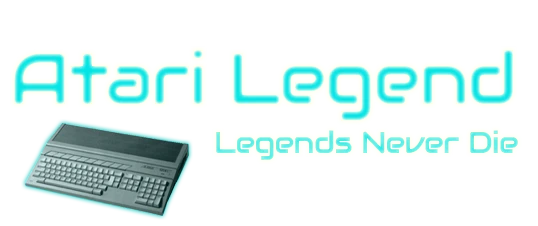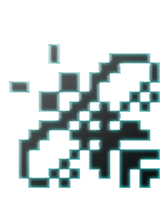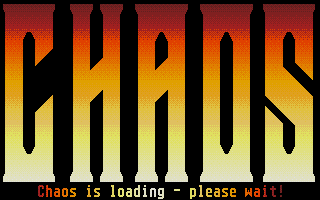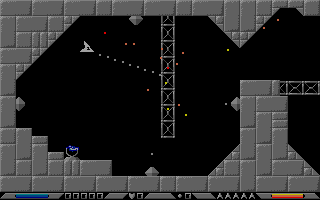







Martin Brownlow is a living legend. Best known among ST fans for creating the beloved PD/shareware classics Grav and Grav 2, his games are still cherished by many to this day. From a young age, Martin knew he wanted to make games for a living...and he made that dream a reality. In fact, he’s still doing it today. Discover the full story and much more in this exciting new interview.
There is currently no profile available in our database

Being a big fan of the original XCOM game on his Spectrum, Martin decided to make a clone on the ST called Chaos.

Just when you thought things could not get any better, Grav 2 got released. The Grav series has turned Martin into a true shareware hero ... even beyond the borders of our beloved ST.
1) Hi Martin, Would you be able to give us a small introduction to those of us that haven't heard of you before? I noticed you were involved with many atari st games and were one of the main programmers of many of the games.
Sure.
Hi!
I started programming at age 12 in the early 80’s. The first and only job I ever wanted was to be a game programmer. All the ST games I made were created for fun while I was in high school / first year of university. I was the sole programmer on all these games and did most of the graphics. All these games were created directly in assembly language.
After graduating from university, I got a job as a professional programmer and never looked back.
2) I wonder if it was one of your earlier games which was called Tanx if I have the correct name. Would you be able to give us a quick description of the game as well as what things you worked on while making the game?
Tanx was a very simple game. Basically you and your opponent each control a tank, and there’s a big hill between you. The aim is to fire a ballistic shot over the hill to destroy the other tank. You can move left and right, and change the angle of your shots.
Like all the ST games, I did almost everything myself. I was 15-19 during this period, and in high school, then university.
3) Did you work on a game called Chaos, would you be able to give us a quick description and what you worked on during the making of the Chaos game? I noticed you can have eight wizards in the game, (lol)
Yes, I made a game called Chaos. It was a remake of a game I used to play on the Spectrum by Julian Gollop (who later went on to make the original X-Com games). My friend ripped all the graphics from the original spectrum version, and we re-colored them (the original spectrum versions were basically monochrome). I added a bunch of sound samples from all my favorite films and TV shows and attached them to certain spells in as funny a way as possible. I tried to make the gameplay as close to the original as possible. I did end up adding a couple of new spells, but the only one I can remember is “Alien” that summoned a Geiger style alien.
4) I love the name of this game Abombinaball and the levels look very nice and colourful, could you give us a quick description of the objective of the game and what you worked on as well in relation to the game? I quite like this game as it has a unique objective to it if I may say so.
Abombinaball was a puzzle game. The aim was to defuse the bombs as they became active. You had 10 secons to reach the next bomb. The catch was that the tiles that made up the level fell away when you left them. You had the ability to jump over a single tile without touching it, but the number of jumps per level was limited. I think there were around 100 levels.
5) Now many of us will know the two Grav games quite well, for those of us that haven't played the game what is the objective and could you give how you got on in the making of the two Grav games.
Grav was inspired by the classic game, Thrust. The aim is to control your ship against gravity and maneuver through various levels. In Grav 2, you also had to land next to information repositories to get the location of the next levels. Out of the thirty or so levels, I think you could finish it whilst only completing 8 if you picked the right path.
Again, all these games we are talking about I made between age 15-19, whilst in school and university. All the programming and most of the graphics were created solely by me.
6) The Grav games does have a bit of a learning curve as I noticed there was a like a training type level you could play first before you go onto the main game. The game is quite difficult at first but the more you practice the better you get. What did you think of the difficulty?
Personally, I got very good at Thrust-style games even before I made either of the Grav games. I tried to challenge myself with a lot of the levels. Some passages you could only get through by rotating your ship correctly as you moved through them. I can imagine this frustrated a lot of people.
7) What would be the main differences between the two Grav games, was there more levels or a selection of different levels? They both look really good games.
The main difference between the two games was that Grav 1 was solely a vertical scroller, while Grav 2 had smooth vertical scrolling and push horizontal scrolling (when you got to the edge of the screen horizontally, it scrolled enough to put you back to the center of the screen). I did start developing a Grav 3, and that one had an Oids-style shield that you could use to bounce around.
8) Was there any atari st game or other game that inspired you to go and create the games that you have created? I remember there being an amiga game called gravity but I don't think this had any relation to your Grav games.
Grav was based on Thrust. Chaos was a remake of the game of the same name. Gems was a remake of the Atari 400 game, Diamonds. Abominaball was original, and Tanx was based on vague memories of (very) old cartridge console games.
9) How did you find the programming itself, was it quite challenging and what would be your favourite programming language as of now?
I’ve always been a natural at programming. When I was 12, my best friend got a ZX81, and we started making games on it. That’s when I knew what I wanted to do for a living.
Professionally, I make games now in C++. I would say that this is my favorite language, because it is closest to what the machine does. Many modern languages have too many constructs that hide what is done under the hood, and these IMO make you a worse programmer for not knowing how to achieve the same results manually.
10) Out of the games mentioned above was there a particular game you enjoyed working on more and you could you tell us why you enjoyed working on that one more?
I had fun for different reasons making all these games. I guess making Chaos was the most fun, matching the various voice samples to actions in the game for the funniest result. It was also based on a game that my friends and I really enjoyed, so we had a ball recreating it.
11) This might sound a strange question but i Love asking anywhere, have you managed to complete any of the games you made? I usually like asking this as a lot of the times the creators aren't really gamers themselves and atari st games are extremely hard to complete in one run.
Yes, I have completed all the ST games that I made. If you’re a sole developer and you can’t complete the game, how do you know that the game is completable, and that the end sequence doesn’t crash?
Back in those days, I made games that I wanted to play, since I was my own boss. All these games were made for fun.
12) Oh I almost forgot to ask you about the game GEMS which I think you were the programmer for, could you give us a description and tell us how you got on with the making of that particular game?
My neighbor had an Atari 400 and we really enjoyed the game Diamonds. This was an attempt to recreate that game so we could continue to have fun playing it. We tried to match the levels to the original as much as possible, and each enemy matches the one from the original game as close as we could remember.
13) Are you a gamer yourself and if the answer is yes would you be able to give us a few of your favourite games?
Absolutely I am. Although recently the game I have played most is Overwatch. I also have the Hellscream tropy from WoW that they sent out for players that put in (I think) 15 years. I’ve spent a lot of time in Valheim, 7 Days to Die, Cyberpunk and New World.
14) Do you still work in the games industry and are you keeping in touch with your old friends from the past that you used to work with?
Yes, I’m a 30+ year industry veteran. My professional credits include:
MDK, Sacrifice, Armed & Dangerous (PC/Xbox), Afterburner (PSP), Flower (Vita & PS4) , Titanfall (X360), Gravity Rush HD (PS4), Uncharted collection (PS4), Shadow of the Colossus (PS4), Demons’ Souls (PS5), New World (PC/Xbox/PS5)
The people I “worked” with on the ST games were my friends and neighbors.
15) Do you have any favourite films or TV shows you watch on a regular basis? I still have lots of DVD collections myself.
Yeah, my wife and I regularly rewatch Breaking Bad, Stargate SG1, Stargate Atlantis. We also enjoy Firefly and The Office (sad you can’t watch it on Netflix in the US). We also watch unscripted shows like Alone, Forged in Fire (big fan), and Hell’s Kitchen.
16) I really like my board games and being able to play those board games on the computer is quite fun, do you like your board games and what are your favourites if you could name a few?
Unfortunately, I’m not a board gamer. I tend to be the only one to read the rules, and I just don’t want to be in charge all the time.
17) ) Keeping to ST Graveyard, he usually asks this at the end of the previous interviews so here I go. If you could have a drink with anyone, dead or alive, who would it be and what would you ask?
I think I would like to talk with Nikola Tesla, to try and figure out how his mind worked. I don’t know if I would have a specific question though.
August 5, 2025 by grams88
Martin Brownlow is a living legend. Best known among ST fans for creating the beloved PD/shareware classics Grav and Grav 2, his games are still cherished by many to this day. From a young age, Martin knew he wanted to make games for a living...and he made that dream a reality. In fact, he’s still doing it today. Discover the full story and much more in this exciting new interview.
October 4, 2024 by grams88
Stacey Jamieson began his career at DMA Design, working on titles such as Oh No! More Lemmings, Walker, GTA and others. Over the years, he moved on to Electronic Arts (EA), where he contributed to major games like the Star Wars Battlefront series, Mass Effect, and Need for Speed. Today, he is the co-founder of Expression Games, where he continues to pursue his passion for game development. What an exciting career!
July 29, 2024 by grams88
Who doesn't love a good underdog story? Chris Sharp is a noteworthy apprentice of the renowned François Lionet, as he mastered the art of coding with the almighty STOS Basic. Chris crafted a few games for our cherished ST, including fan favourites like Magic Tomb and the Freaked Out series. Intrigued? Dive into our interview to revisit the era when game development could still be a solo endeavour.
July 16, 2024 by grams88
When Sega released its Master System, it came bundled with the game Alex Kid. To this day the game remains very popular, loved by many. One of those people is Terry Lloyd. More so, Alex Kid was the main inspiration for the Atari ST platform classic Axel's Magic Hammer. But that is just one of his many accomplishments. Terry has been around the block. Working as an artist and game designer at the beginning of the 80's for Gremlin Graphics, he then moved on to Core Design, which he helped get off the ground. During the 90's he contributed to founding the company Malibu Interactive. On the Atari ST, Terry's resumé include Dynamite Dux, Car-Vup, Rick Dangerous 1 & 2, Torvak the Warrior, WarZone and many more. Read all about this veteran of the games industry in this exciting interview.
April 18, 2024 by grams88
It doesn't always have to be about computers, coding and graphics. Adrian Powell, the artist behind the original Lemmings game, crafted all its artwork, including box art and promotional materials. His passion for painting lemmings has persisted over time and he is still painting lemmings to this day. Powell's work remains influential and has helped selling millions of copies of this classic (ST) game.
Currently 0 registered users online
In the past 24h there were 2 registered users online